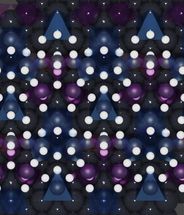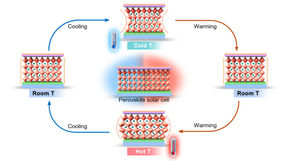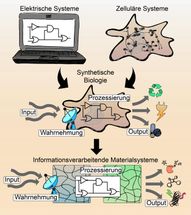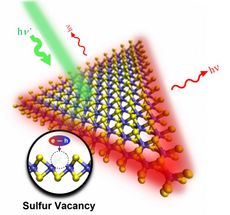A nanoear to listen into the silence
Gold nanoparticles detect tiny acoustic vibrations
How noisy is a walking flea? What sorts of sound waves are caused by motile bacteria? Physicists at the Nanosystems Initiative Munich (NIM) have managed for the first time to detect sound waves at such minuscule length scales. Their nanoear is a single gold nanoparticle that is kept in a state of levitation by a laser beam. Upon weak acoustic excitation the particle oscillates parallel to the direction of sound propagation. The scientists led by Dr. Andrey Lutich, who is a member of Professor Jochen Feldmann’s group at LMU Munich, managed to detect such tiny displacements using a dark-field microscope and an ordinary video camera. The nanoear is capable of detecting sound levels of approximately -60 dB. Thus, it is about a million times more sensitive than the hearing threshold of the human ear, which by convention is set at 0 dB.
The new method realized by the Munich physicists opens a new world to scientists: for the first time, otherwise imperceptibly weak motions – minuscule sound waves – can be visualized. The scientists developed the nanoear in two stages. “First, we validated the basic principle using a relatively strong sound source” group leader Andrey Lutich explains. “In the second step we were able to detect significantly weaker acoustic excitations.” The main element in both cases is a gold nanoparticle, 60 nm in diameter, which is kept in levitation by a so-called optical trap using a red laser. Each of the experiments was done in a small water drop on a cover slide.
In the first case, a needle serves as a sound source. It is glued onto a loudspeaker membrane and emits sound waves towards the trapped gold particle. The scientists successfully detected the oscillations of the trapped particle optically using a dark-field microscope and an ordinary digital camera. The recorded videos, each 30 seconds in length, clearly showed the particle oscillating parallel to the propagation direction of the sound waves.
In a second step, the physicists used the so-called nanoprinting method to fix a small number of gold particles on the cover slide. These particles are heated periodically using a green laser. As a result they emit very weak sound waves towards the single levitating gold nanoparticle. The interaction between the sound waves and the trapped particle is very weak. Therefore, the displacement of the particle cannot be detected directly with available optical methods. The scientists used the mathematical Fourier Transformation to obtain the frequency spectrum of the particle's motion. The physicists could show that the frequency of the sound source is clearly enhanced in this spectrum. Control experiments in which the sound source is driven at varying frequencies confirmed this observation and the high sensitivity of the nanoear.
“With our nanoear, we have developed a nanomicrophone that allows us to get closer than ever to microscopic objects” Alexander Ohlinger, first author of the publication, explains. “By observing the oscillations of a single gold nanoparticle, tiny movements can be detected.” In this way, the nanoear could yield important information on the minute motions of cells, cell organelles or artificial microscopic objects. Additionally, no high-end devices are necessary as only well-established methods are used.
Original publication
Optically Trapped Gold Nanoparticle Enables Listening at the Microscale. Alexander Ohlinger, Andras Deak, Andrey A. Lutich, and Jochen Feldmann. Phys. Rev. Lett. 108, 018101 (January 2012)
Most read news
Original publication
Optically Trapped Gold Nanoparticle Enables Listening at the Microscale. Alexander Ohlinger, Andras Deak, Andrey A. Lutich, and Jochen Feldmann. Phys. Rev. Lett. 108, 018101 (January 2012)
Organizations
Other news from the department science
These products might interest you
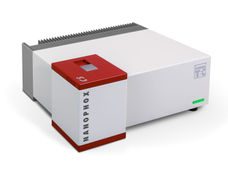
NANOPHOX CS by Sympatec
Particle size analysis in the nano range: Analyzing high concentrations with ease
Reliable results without time-consuming sample preparation

DynaPro Plate Reader III by Wyatt Technology
Screening of biopharmaceuticals and proteins with high-throughput dynamic light scattering (DLS)
Efficiently characterize your sample quality and stability from lead discovery to quality control

Eclipse by Wyatt Technology
FFF-MALS system for separation and characterization of macromolecules and nanoparticles
The latest and most innovative FFF system designed for highest usability, robustness and data quality

Get the chemical industry in your inbox
By submitting this form you agree that LUMITOS AG will send you the newsletter(s) selected above by email. Your data will not be passed on to third parties. Your data will be stored and processed in accordance with our data protection regulations. LUMITOS may contact you by email for the purpose of advertising or market and opinion surveys. You can revoke your consent at any time without giving reasons to LUMITOS AG, Ernst-Augustin-Str. 2, 12489 Berlin, Germany or by e-mail at revoke@lumitos.com with effect for the future. In addition, each email contains a link to unsubscribe from the corresponding newsletter.


